
Galicia is an autonomous community of Spain and historic nationality under Spanish law. Located in the northwest Iberian Peninsula, it includes the provinces of A Coruña, Lugo, Ourense, and Pontevedra.

Santiago de Compostela, simply Santiago, or Compostela, is the capital of the autonomous community of Galicia, in northwestern Spain. The city has its origin in the shrine of Saint James the Great, now the Cathedral of Santiago de Compostela, as the destination of the Way of St. James, a leading Catholic pilgrimage route since the 9th century. In 1985, the city's Old Town was designated a UNESCO World Heritage Site.

Ferdinand II, was a member of the Castilian cadet branch of the House of Ivrea and King of León and Galicia from 1157 until his death.

Baroque architecture is a highly decorative and theatrical style which appeared in Italy in the early 17th century and gradually spread across Europe. It was originally introduced by the Catholic Church, particularly by the Jesuits, as a means to combat the Reformation and the Protestant church with a new architecture that inspired surprise and awe. It reached its peak in the High Baroque (1625–1675), when it was used in churches and palaces in Italy, Spain, Portugal, France, Bavaria and Austria. In the Late Baroque period (1675–1750), it reached as far as Russia, the Ottoman Empire and the Spanish and Portuguese colonies in Latin America. In about 1730, an even more elaborately decorative variant called Rococo appeared and flourished in Central Europe.

Lugo is a city in northwestern Spain in the autonomous community of Galicia. It is the capital of the province of Lugo. The municipality had a population of 98,025 in 2018, making it the fourth most populous city in Galicia.

The Santiago de Compostela Arch cathedral Basilica is part of the Metropolitan Archdiocese of Santiago de Compostela and is an integral component of the Santiago de Compostela World Heritage Site in Galicia, Spain. The cathedral is the reputed burial place of Saint James the Great, one of the apostles of Jesus Christ. It is also among the remaining churches in the world built over the tomb of an apostle, the other ones being St Peter's Basilica in Vatican City, St Thomas Cathedral Basilica in Chennai, India and Basilica of St. John in Izmir, Turkey.
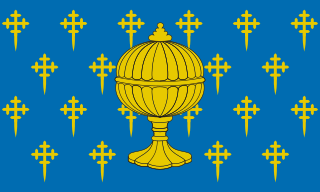
The Kingdom of Galicia was a political entity located in southwestern Europe, which at its territorial zenith occupied the entire northwest of the Iberian Peninsula. It was founded by the Suebic king Hermeric in 409, with its capital established in Braga. It was the first kingdom that officially adopted Catholicism. In 449, it minted its own currency. In 585, it became a part of the Visigothic Kingdom. In the 8th century, Galicia became a part of the newly founded Christian Kingdom of Asturias, which later became the Kingdom of León, while occasionally achieving independence under the authority of its own kings. Compostela became the capital of Galicia in the 11th century, while the independence of Portugal (1128) determined its southern boundary. The accession of Castilian King Ferdinand III to the Leonese kingdom in 1230 brought Galicia under the control of the Crown of Castile.

Spanish Baroque is a strand of Baroque architecture that evolved in Spain, its provinces, and former colonies.

Spanish architecture refers to architecture in any area of what is now Spain, and by Spanish architects worldwide. The term includes buildings which were constructed within the current borders of Spain prior to its existence as a nation, when the land was called Iberia, Hispania, or was divided between several Christian and Muslim kingdoms. Spanish architecture demonstrates great historical and geographical diversity, depending on the historical period. It developed along similar lines as other architectural styles around the Mediterranean and from Central and Northern Europe, although some Spanish constructions are unique.
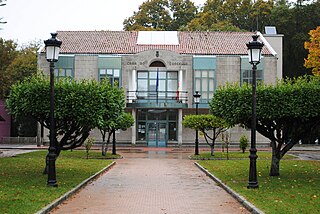
O Saviñao is a Concello (council) in the province of Lugo, Galicia belonging to the district of Terra de Lemos. The main town for the council is Escairón.
Munio or Muño Peláez was a Galician magnate, a member of the Banu Gómez clan, during the reigns of Alfonso VI, Urraca and Alfonso VII. By December 1108 he held the title of comes (count), the highest in the kingdom. He was a son of count Pelayo Gómez, grandson son of Gómez Díaz de Carrión and Teresa Peláez. His mother was Elvira Muñoz, half-sister of count Rodrigo Muñoz, and daughter of Munio Rodríguez and Ilduara Velázquez. Elvira's ancestors had founded the monastery of Santa María de Ferreira.

Pedro Fróilaz de Traba was the most powerful secular magnate in the Kingdom of Galicia during the first quarter of the twelfth century. According to the Historia compostelana, he was "spirited ... warlike ... of great power ... a man who feared God and hated iniquity," for Diego Gelmírez himself had "fed him, like a spiritual son, with the nutriment of holy teaching." Brought up at the court of the Emperor Alfonso VI, Pedro raised the future Emperor Alfonso VII in his household. Around the latter he and Diego formed a "Galician party" that dominated that region during the turbulent reign of Urraca (1109–26). In September 1111 they even had the child Alfonso crowned king at Santiago de Compostela, but it was Pedro who was imperator in orbe Galletiae.
Enrique Cal Pardo was a Spanish Galician priest, teacher and writer. He was born in Galdo, Viveiro, (Galicia).

Rodrigo Vélaz was the "count of Galicia, who held Sarria" according to the near-contemporary Chronica Adefonsi imperatoris. During his long public career he was the dominant figure in mountainous eastern Galicia while the House of Traba dominated its western seaboard. He served under three monarchs—Alfonso VI, Urraca, and Alfonso VII—and was loyal to all of them, never figuring in any rebellion. The contemporary Historia compostellana is a valuable source for his life, since there are no aristocratic archives surviving in Spain from this period. Rodrigo's career must be pieced together from the few references in the chronicles and the charters preserved in various ecclesiastical archives.

Saint Mary's Cathedral, better known as Lugo Cathedral, is a Roman Catholic church and basilica in Lugo, Galicia, north-western Spain. The cathedral was erected in the early 12th century in a Romanesque style, with Gothic, Baroque and Neoclassical elements.

The monastery of San Martiño Pinario was a Benedictine monastery in the city of Santiago de Compostela, Galicia, Spain. It is the second largest monastery in Spain after San Lorenzo de El Escorial.
Fernando Seoane Antelo is a Spanish former professional footballer who played as a defensive midfielder.
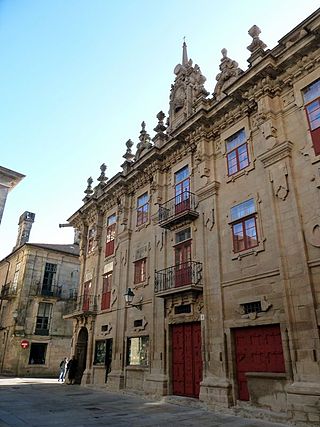
Casa do Cabido is a historic house in Santiago de Compostela, Province of A Coruña, Galicia, Spain, facing the Praza de Praterías. It was designed for urban beautification in order to decorate and match the surroundings and completed in 1758 in the baroque style.
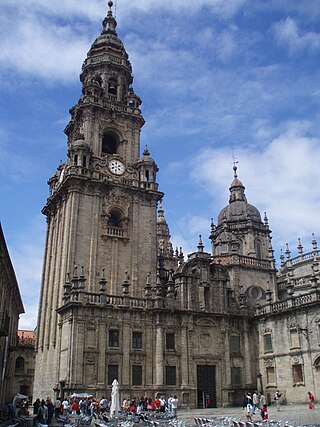
Domingo Antonio de Andrade was a Galician baroque architect, a leading figure in the emergence of Galician Baroque architecture.
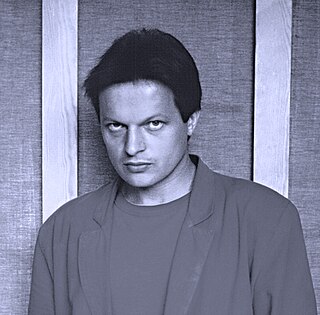
Xosé Artiaga Barreira, is a Galician painter, engraver, photographer and multimedia artist, as well as teacher of drawing.

















